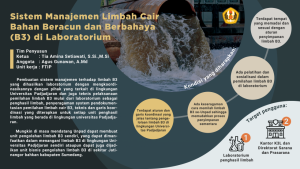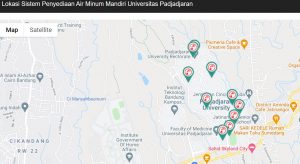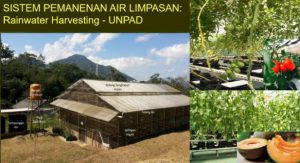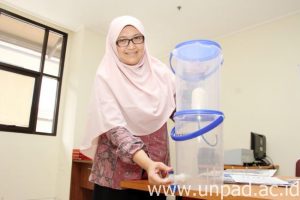
SDG 6: CLEAN WATER AND SANITATION
Water is the main need of living things. Without water, living things such as humans, plants and animals cannot survive. In addition, water is also useful for supporting agricultural and aquaculture production that is useful for humans.
Clean water is very important for the survival of living things. However, due to inadequate economy and infrastructure, millions of people die every year due to diseases caused by inadequate supply of clean water, sanitation and environmental hygiene.
Water consumption per person
- Water consumption tracking
- Volume of water used in the university
Water consumption tracking , measuring the total volume of water used at the university drawn from power supplies, desalination, or drawn from rivers, lakes or aquifers.
1. Effect of Drinking Water Consumption from Springs in High Radon Concentration Areas on the Occurrence of Caries
Radon is a naturally occurring radioactive gas. Exposure to radon is not only present in the air but also in water. The purpose of this study was to determine the effect of drinking water consumption from springs in areas of high radon concentration on the occurrence of caries. The influence between consumption of drinking water containing radon on the occurrence of caries is weak but significant and has a positive or directly proportional effect, which means that the higher the concentration of radon in drinking water, the higher the chance of caries. There is an influence between the consumption of drinking water containing radon on the occurrence of caries. The higher the concentration of radon in drinking water, the more caries that occur.
Volume of water used (in cubic metres) in the university sourced from treated/extracted water.
Water usage and care
- Waste water treatment
- Preventing water system pollution
- Free drinking water provided
- Water-conscious building standards
- Water-conscious planting
Efforts made by Padjadjaran University on the process of treating wastewater.
Waste management at Padjadjaran University

1. Toxic and Hazardous (B3) Liquid Waste Management System in the Laboratory
The laboratory in universities is one of the main units that produce toxic and hazardous waste (B3) as a result of activities related to the Tri dharma of higher education. Of the 16 faculties at Padjadjaran University, there are around 115 laboratories. Improvements are made so that the process of coordinating the sorting and disposal of B3 waste produced by the laboratory is appropriate and does not cause problems for work safety and security as well as the environment.
a. there are clear rules and coordination lines regarding B3 waste management within the University of Padjadjaran
b. there is training and socialization in the sorting of B3 waste in the laboratory
c. there is uniformity in how to sort B3 waste throughout Unpad, making it easier for temporary storage
d. there is an adequate place and in accordance with the rules for storing B3 waste.
( Toxic and Hazardous (B3) Liquid Waste Management System in the Laboratory )
Implement processes to prevent polluted water from entering the water system, including pollution caused by accidents and incidents at universities.

1. Natural Stone Waste Pollution in the Jamblang River, Cirebon Has Not Been Handled
The contamination of natural stone waste in the Jamblang River, Palimanan District, Cirebon Regency, is still unresolved. The Jamblang River is polluted by natural stone waste due to irresponsible natural stone production. This pollution started in 1999 until now. In addition to the problem of strong odors, the polluted Jamblang river also holds other threats. Natural stone waste in the form of residue, settles on the riverbed. The village government has tried various ways to deal with natural stone waste. However, these efforts are considered less effective in solving the problem. According to Vivi, the government’s efforts have been carried out by dredging up natural stone waste that has settled. However, the community also needs to be given counseling not to throw garbage in the river.
( Natural Stone Waste Pollution in the Jamblang River, Cirebon Has Not Been Handled )
2. Fine Bubble Generator, Water Quality Management and Aquaculture Solution
Fine Bubbles are very small air bubbles in water, with that size, the oxygen content produced is much more and can kill bad bacteria. The function of the Fine Bubble is for the water management system (2:20). High oxygen in the water will make a good metabolism in water quality and aquaculture.
( Fine Bubble Generator, Water Quality Management and Aquaculture Solution )
3. Noir Primadona Purba, M.Sc., Designs a Low-Cost, Reliable, and Effective Water Measuring Instrument
Lecturer of the Department of Marine Affairs, Faculty of Fisheries and Marine Sciences, Universitas Padjadjaran Noir Primadona Purba, M.Sc., explained that this measurement is very important because Indonesian waters have an ocean current (Indonesian Throughflow). This current is one of the systems that can change the characteristics of global waters. This research succeeded in developing an instrument called “RHEA” or (Drifter GPS Oceanography Coverage Area). In short, RHEA is an instrument intended to measure currents in a lagrangian manner. That is, this tool follows the water parcel wherever the current flows. Not only in the ocean, RHEA can also be used in closed waters such as lakes, reservoirs, or very shallow waters. In addition to measuring current, sensors in RHEA are also installed for measuring air and water temperature, pH, oxygen, turbidity, pressure, and position. In fact, said Noir, the installation of sensors can be tailored to the needs and desires of users. In inland water areas, RHEA is very effective for monitoring water quality. Thus, users can anticipate if the water quality in a lake or reservoir deteriorates. In some cases, fish deaths in lakes cannot be prevented due to delays in information about water quality degradation.
( Noir Primadona Purba, M.Sc., Designs a Low-Cost, Reliable, and Effective Water Measuring Instrument )
Provide free drinking water for students, staff and visitors (eg drinking fountain).
1. Location of Padjadjaran University Independent Drinking Water Supply System

( Location of Padjadjaran University Independent Drinking Water Supply System )
Apply building standards to minimise water use

1. Utilization of Water from Rainwater Harvesting System from Building Roof
In the rainwater harvesting system from the roof of the greenhouse, the collected rainwater is used as a source of irrigation water for the cultivation of vegetables, cherry tomatoes and melo. The system built can accommodate as much as 21 m3 of rainwater which is used to supply irrigation water needs throughout the year.
( Utilization of Water from Rainwater Harvesting System from Building Roof)
Planting landscapes to minimize water use. For example, using drought-resistant plants.

1. Sustainable Tourism Masters Program Together with Unpad Public Relations Study Program Commemorates World Water Day
The Postgraduate School of Sustainable Tourism Masters study program and the Public Relations study program of the Faculty of Communication Sciences, Padjadjaran University organize a number of activities to commemorate World Water Day or World Water Day which falls every March 22. This activity is also a form of Unpad’s contribution in achieving the SDGs, especially the 6th goal of ensuring the availability and sustainable management of water for everyone. The activity continued with a talk show with the theme “Leaving No One Behind” which discussed water and tourism.
2. Seeing the Sustainable Water Resources Management Efforts from Prof. Hendarmawan
Padjadjaran University won the international award “Green Award 2017” from The Green Organization, last December 11. The award was given for research related to sustainable water resource management by a number of interdisciplinary lecturers. The Dean of the Unpad Graduate School who is also the head of the “sustainable water resources” research team, Prof. Dr. Hendarmawan, Ir., M.Sc., stated that this research seeks to conserve water availability in industrial and residential areas through certain engineering methods. If the availability of groundwater is taken continuously in large quantities by the industry, it is feared that in the next few years it will continue to shrink. This was then dealt with by Prof. Hendarmawan and team. After carrying out several stages, the team carried out monitoring of ground water. In the industrial area, several monitoring wells have been built that can detect groundwater levels. As a result, through this micro-engineering, the availability of water in industrial areas increases.
( Seeing the Sustainable Water Resources Management Efforts from Prof. Hendarmawan )
Water reuse
- Water reuse policy
- Water reuse measurement
Have a policy to maximize water reuse.

1. UNPAD policy is recommended to reuse water use
Faculties and units at UNPAD are advised to reuse water use, by:
a. Rainwater reuse.
b. Construction of infiltration wells.
c. Utilization of Greywater for irrigation and construction.
( UNPAD policy is recommended to reuse water use )
2. Sri Yusnita Irda Sari, dr., M.Sc., Develops a Prototype of Flood Water Filter into Ready-to-Drink Water
Flood is one of the most frequent disasters in Indonesia. The clean water crisis is at least one of the main problems faced by floods. Water contamination by various wastes and garbage carried during floods makes it difficult to get clean water for drinking or daily needs. This condition aroused the Lecturer of the Department of Public Health, Faculty of Medicine, Unpad, dr. Sri Yusnita Irda Sari, M.Sc., to find a solution to get clean water cheaply, effectively, and efficiently. Departing from these conditions, Sri through the Center for Health Technology Studies Unpad FK in collaboration with PT. Holland for Water as the maker of the “Nazava” branded water filter has developed a prototype of a water filter that can convert flooded/polluted water into potable water.
Measure the reuse of water across the university?

1. Toxic and Hazardous (B3) Liquid Waste Management System in the Laboratory
The laboratory in universities is one of the main units that produce toxic and hazardous waste (B3) as a result of activities related to the Tri dharma of higher education. Of the 16 faculties at Padjadjaran University, 10 of them are exact science faculties, with the number of laboratories in all exact faculties and one directorate totaling 115 laboratories. From 115 laboratories based on a survey via Google Forms conducted in August 2020, there were 60 respondent laboratories that filled out the survey and generated waste in the categories of domestic waste, B3 waste, medical waste and biohazard waste. So far, there has been no socialization, clear rules and coordination lines in terms of B3 waste management in Unpad. For this reason, it is necessary to make improvements so that the process of coordinating the sorting and disposal of B3 waste produced by the laboratory is appropriate and does not cause problems for work safety and security as well as the environment.
In this proposal, a management system for the B3 waste produced by the laboratory will be created by coordinating it with related parties within the University of Padjadjaran and also the technical implementation of B3 waste sorting starting from the laboratory as a waste producer, uniformity of the documentation system for the separation of B3 liquid waste, technical and coordination lines. applied to every waste-generating unit located within the University of Padjadjaran, maybe in the future Unpad can create its own B3 waste treatment unit, which can be used to handle B3 waste within the University of Padjadjaran itself or can also be used as a business unit for B3 waste processing around Jatinangor even Sumedang district.
( Toxic and Hazardous (B3) Liquid Waste Management System in the Laboratory )
2. Padjadjaran University Hospital RSHS Introduces Waste Treatment System with BMW
RSUP dr. Hasan Sadikin held a socialization of non-medical waste management with the BMW system (Biotechnology Maggot and Zero Waste) with participants from all hospitals in Bandung. Hospitals are a large contributor to waste, and the amount of non-medical waste in hospitals reaches around 60%. Therefore, efforts are needed to manage it so that the waste produced does not add to the burden of the landfill and has a negative impact on environmental sustainability. In general, the BMW system is a biological organic waste management technique using larva maggot agent which is the most environmentally friendly, effective and efficient new technique. The maggot itself comes from the BSF fly (black soldier fly) or known as the black fly (Hermetia illucent) which has the shortest life cycle, the largest reproduction and can eat various organic waste materials in a relatively short time. With this system, it is hoped that the volume of waste will be greatly reduced and efficiency will be realized. This program received a good response from the West Java Provincial Health Office, Bandung City Health Office and the Environmental Health Office. According to input from stakeholders, this socialization will not stop here. There will be a further meeting to strengthen the commitment of all hospitals in the city of Bandung and 7 West Java Regional Hospitals in managing medical waste and realizing a green hospital. RSHS also has a mini lab as a medium for socialization / training for other institutions who want to learn about the management of BMW so that the impact is greater.
( First in Indonesia, RSHS Introduces Waste Treatment System with BMW )
3. How Padjadjaran University Hospital RSHS Manages Medical Waste
Maudi said the medical waste in the form of body tissue was in the form of tumors, flesh, skin from surgery and pieces of amputated body parts. Only a small part of the medical waste can be recycled. Meanwhile, medical waste that can be recycled in accordance with Minister of Environment Regulation P56/2015 is packaging for infusion fluids and injection tubes. Meanwhile, needles and other waste categorized as waste will be destroyed by burning.
Water in the community
- Water management educational opportunities
- Promoting conscious water usage
- Off-campus water conservation support
- Sustainable water extraction on campus
- Cooperation on water security
Provide educational opportunities for local communities to learn about good water management.

1. Unpad Shares the Experience of Managing Campuses with the Concept of Sustainability
Universitas Padjadjaran dipercaya menjadi salah satu pendukung acara “National Workshop on Environmental Sustainability 2019” di Bandung, bekerja sama dengan UI Greenmetric dan Telkom University. Kepada para peserta, Unpad mempresentasikan mengenai pengelolaan lingkungan kampus yang sudah dilakukan. Adapun tema yang diangkat pada acara tersebut adalah “Raising the Participation of Higher Education on Nurturing the Environment Through Sustainability Office”. Pada kesempatan tersebut, Dr. Sigid memaparkan menegenai arsitektur tata kelola Unpad menuju konsep kantor keberlanjutan (sutainability office). Ia menjelaskan, fokus keberlanjutan di Unpad di antaranya terkait tata kelola dan infrastruktur, pengelolaan energi, pengelolaan sampah, pengelolaan air, transportasi, pendidikan, dan penelitian. Beberapa kebijakan strategis Unpad dalam hal pengelolaan lingkungan di antaranya terkait pembangunan infrasturktur dengan konsep keberlanjutan, pengelolaan sampah di lingkungan kampus, pengelolaan sumber air tanah, pengurangan jumlah kendaraan pribadi di lingkungan kampus, hingga pengurangan penggunaan kertas dan plastik.
( Unpad Shares the Experience of Managing Campuses with the Concept of Sustainability )
Actively promote the conscious use of water on campus, and in the wider community
1. Actively promote the conscious use of water on campus, and in the wider community
Faculties and units at UNPAD are required to maintain effectiveness and efficiency in water use, by:
a. Regular inspection of faucets, pipes, toilets.
b. Do not use the toilet as a smoking area or trash can.
c. Use a water meter to detect leaks.
d. Use a bottle in the toilet tank to reduce the volume of water.
e. Turn off the water tap when not in use.
f. Watering the grass according to the specified time.
( Actively promote the conscious use of water on campus, and in the wider community )
Support water conservation off campus
1. Efforts to Improve Environmental Conditions in the Citarum River Basin
Currently, the Citarum watershed has various problems from upstream to downstream. The problems in the upstream areas stem from the loss of water catchment sources due to deforestation and the conversion of protected forest functions into plantation land such as coffee. The next problem is livestock waste which is directly dumped into the river, causing pollution that contaminates the river water. The government issued a solution known as the “Citarum Harum” program. The Citarum Harum program has a focus on fixing problems around the Citarum watershed that have a negative impact on the community. The Citarum Harum Thematic PPM Program aims to overcome the problems in the Citarum watershed. This community service activity aims to improve environmental conditions in the Citarum watershed, which consists of 5 main focuses, namely waste management, water conservation, disaster mitigation, environmental sanitation and the existence of critical land in Cilengkrang Village, Cilengkrang District, Bandung Regency. The method of activities carried out is in the form of education and assistance for the community which is carried out for 2 weeks related to waste management, critical land, water conservation, environmental sanitation and disaster mitigation carefully. One of the activities is to build Rorak, a dead-end ditch with a certain depth. In addition to rorak, education has also been carried out to the public regarding the importance of maintaining personal hygiene and managing animal waste so that they can maintain good environmental sanitation. The community has also been given education about the risk of landslides that may occur because the contours of the Cilengkrang village which is in a mountainous area and the drought that hit and the rainy season that has started to put this area at risk for landslides. The results of the service activities that have been carried out show an increase in public awareness about critical land, water conservation, waste management, environmental sanitation and disaster mitigation. To maintain this condition, it is necessary to carry out continuous activities to be able to continue to increase the motivation and awareness of the community to do these five things so that the objectives of Citraum Harum can be achieved.
( Efforts to Improve Environmental Conditions in the Citarum River Basin )
2. CCR, Unpad Research Base for Citarum River Revitalization
Citarum is a river that is the pulse of most of the people of West Java. Unfortunately, this 270 km long river was included in the World Bank’s list of the dirtiest rivers in the world in 2018. This is because Citarum pollution has been categorized as heavy and has a high sedimentation rate. Head of CCR Unpad Dr. Cipta Endyana, M.T., explained that the Unpad CCR was established following the need for an academic perspective in solving problems in Citarum. Therefore, research activities at CCR are not only focused on one scientific field, but are multidisciplinary. Currently, the appointment of a regional coordinator is still being discussed by Fact. Unpad itself is likely to be concentrated in the Citarik sub-basin area, one of the sub-basins in the Citarum watershed. “Because Unpad is located in Jatinangor, which is part of the Citarik sub-basin, we are most likely there,” said Cipta.
( CCR, Unpad Research Base for Citarum River Revitalization )
Where water is extracted (for example from aquifers, lakes or rivers) utilise sustainable water extraction technologies on associated university grounds on and off campus.
Collaborate with local, regional, national, or global governments on water security.
1. COMMUNITY-BASED WATER MANAGEMENT: A Legal Perspective Overview
Water is a gift from God to his people, including all Indonesian people, while Article 33 paragraph 3 of the 1945 Constitution mandates that control over the earth, water, and space, as well as the wealth contained therein, is to be used as much as possible for the prosperity of the people. The Water Resources Law provides regional authorities and responsibilities for the management of water resources, namely in terms of establishing policies for water resources management, establishing patterns of water resource management, establishing water resources management plans, establishing and managing protected areas for water resources, implementing water resources management. , regulate, stipulate and give permits for the supply, designation, use, and exploitation of water, establish a water resources council, fulfill the daily minimum basic needs for water and maintain the effectiveness, efficiency, quality, and orderliness of the implementation of water resources management in river areas. in one district/city. The management and provision of clean water in Bentenan Village is carried out by the Village Government, through the Clean Water Management Unit whose management is determined and or selected through village meetings.
( COMMUNITY-BASED WATER MANAGEMENT: A Legal Perspective Overview )
